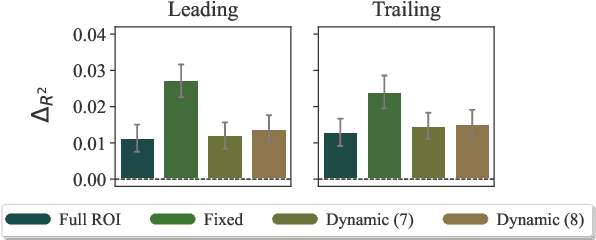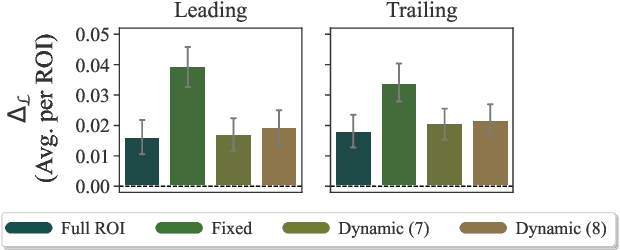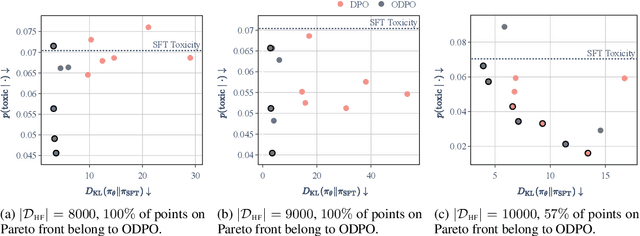Tim Vieira
Language Models over Canonical Byte-Pair Encodings
Jun 09, 2025Abstract:Modern language models represent probability distributions over character strings as distributions over (shorter) token strings derived via a deterministic tokenizer, such as byte-pair encoding. While this approach is highly effective at scaling up language models to large corpora, its current incarnations have a concerning property: the model assigns nonzero probability mass to an exponential number of $\it{noncanonical}$ token encodings of each character string -- these are token strings that decode to valid character strings but are impossible under the deterministic tokenizer (i.e., they will never be seen in any training corpus, no matter how large). This misallocation is both erroneous, as noncanonical strings never appear in training data, and wasteful, diverting probability mass away from plausible outputs. These are avoidable mistakes! In this work, we propose methods to enforce canonicality in token-level language models, ensuring that only canonical token strings are assigned positive probability. We present two approaches: (1) canonicality by conditioning, leveraging test-time inference strategies without additional training, and (2) canonicality by construction, a model parameterization that guarantees canonical outputs but requires training. We demonstrate that fixing canonicality mistakes improves the likelihood of held-out data for several models and corpora.
Syntactic Control of Language Models by Posterior Inference
Jun 08, 2025Abstract:Controlling the syntactic structure of text generated by language models is valuable for applications requiring clarity, stylistic consistency, or interpretability, yet it remains a challenging task. In this paper, we argue that sampling algorithms based on the posterior inference can effectively enforce a target constituency structure during generation. Our approach combines sequential Monte Carlo, which estimates the posterior distribution by sampling from a proposal distribution, with a syntactic tagger that ensures that each generated token aligns with the desired syntactic structure. Our experiments with GPT2 and Llama3-8B models show that with an appropriate proposal distribution, we can improve syntactic accuracy, increasing the F1 score from $12.31$ (GPT2-large) and $35.33$ (Llama3-8B) to about $93$ in both cases without compromising the language model's fluency. These results underscore both the complexity of syntactic control and the effectiveness of sampling algorithms, offering a promising approach for applications where precise control over syntax is essential.
Syntactic and Semantic Control of Large Language Models via Sequential Monte Carlo
Apr 18, 2025



Abstract:A wide range of LM applications require generating text that conforms to syntactic or semantic constraints. Imposing such constraints can be naturally framed as probabilistic conditioning, but exact generation from the resulting distribution -- which can differ substantially from the LM's base distribution -- is generally intractable. In this work, we develop an architecture for controlled LM generation based on sequential Monte Carlo (SMC). Our SMC framework allows us to flexibly incorporate domain- and problem-specific constraints at inference time, and efficiently reallocate computational resources in light of new information during the course of generation. By comparing to a number of alternatives and ablations on four challenging domains -- Python code generation for data science, text-to-SQL, goal inference, and molecule synthesis -- we demonstrate that, with little overhead, our approach allows small open-source language models to outperform models over 8x larger, as well as closed-source, fine-tuned ones. In support of the probabilistic perspective, we show that these performance improvements are driven by better approximation to the posterior distribution. Our system builds on the framework of Lew et al. (2023) and integrates with its language model probabilistic programming language, giving users a simple, programmable way to apply SMC to a broad variety of controlled generation problems.
Better Estimation of the KL Divergence Between Language Models
Apr 14, 2025Abstract:Estimating the Kullback--Leibler (KL) divergence between language models has many applications, e.g., reinforcement learning from human feedback (RLHF), interpretability, and knowledge distillation. However, computing the exact KL divergence between two arbitrary language models is intractable. Thus, practitioners often resort to the use of sampling-based estimators. While it is easy to fashion a simple Monte Carlo (MC) estimator that provides an unbiased estimate of the KL divergence between language models, this estimator notoriously suffers from high variance, and can even result in a negative estimate of the KL divergence, a non-negative quantity. In this paper, we introduce a Rao--Blackwellized estimator that is also unbiased and provably has variance less than or equal to that of the standard Monte Carlo estimator. In an empirical study on sentiment-controlled fine-tuning, we show that our estimator provides more stable KL estimates and reduces variance substantially in practice. Additionally, we derive an analogous Rao--Blackwellized estimator of the gradient of the KL divergence, which leads to more stable training and produces models that more frequently appear on the Pareto frontier of reward vs. KL compared to the ones trained with the MC estimator of the gradient.
Fast Controlled Generation from Language Models with Adaptive Weighted Rejection Sampling
Apr 07, 2025Abstract:The dominant approach to generating from language models subject to some constraint is locally constrained decoding (LCD), incrementally sampling tokens at each time step such that the constraint is never violated. Typically, this is achieved through token masking: looping over the vocabulary and excluding non-conforming tokens. There are two important problems with this approach. (i) Evaluating the constraint on every token can be prohibitively expensive -- LM vocabularies often exceed $100,000$ tokens. (ii) LCD can distort the global distribution over strings, sampling tokens based only on local information, even if they lead down dead-end paths. This work introduces a new algorithm that addresses both these problems. First, to avoid evaluating a constraint on the full vocabulary at each step of generation, we propose an adaptive rejection sampling algorithm that typically requires orders of magnitude fewer constraint evaluations. Second, we show how this algorithm can be extended to produce low-variance, unbiased estimates of importance weights at a very small additional cost -- estimates that can be soundly used within previously proposed sequential Monte Carlo algorithms to correct for the myopic behavior of local constraint enforcement. Through extensive empirical evaluation in text-to-SQL, molecular synthesis, goal inference, pattern matching, and JSON domains, we show that our approach is superior to state-of-the-art baselines, supporting a broader class of constraints and improving both runtime and performance. Additional theoretical and empirical analyses show that our method's runtime efficiency is driven by its dynamic use of computation, scaling with the divergence between the unconstrained and constrained LM, and as a consequence, runtime improvements are greater for better models.
From Language Models over Tokens to Language Models over Characters
Dec 04, 2024Abstract:Modern language models are internally -- and mathematically -- distributions over token strings rather than \emph{character} strings, posing numerous challenges for programmers building user applications on top of them. For example, if a prompt is specified as a character string, it must be tokenized before passing it to the token-level language model. Thus, the tokenizer and consequent analyses are very sensitive to the specification of the prompt (e.g., if the prompt ends with a space or not). This paper presents algorithms for converting token-level language models to character-level ones. We present both exact and approximate algorithms. In the empirical portion of the paper, we benchmark the practical runtime and approximation quality. We find that -- even with a small computation budget -- our method is able to accurately approximate the character-level distribution (less than 0.00021 excess bits / character) at reasonably fast speeds (46.3 characters / second) on the Llama 3.1 8B language model.
On the Proper Treatment of Tokenization in Psycholinguistics
Oct 03, 2024



Abstract:Language models are widely used in computational psycholinguistics to test theories that relate the negative log probability (the surprisal) of a region of interest (a substring of characters) under a language model to its cognitive cost experienced by readers, as operationalized, for example, by gaze duration on the region. However, the application of modern language models to psycholinguistic studies is complicated by the practice of using tokenization as an intermediate step in training a model. Doing so results in a language model over token strings rather than one over character strings. Vexingly, regions of interest are generally misaligned with these token strings. The paper argues that token-level language models should be (approximately) marginalized into character-level language models before they are used in psycholinguistic studies to compute the surprisal of a region of interest; then, the marginalized character-level language model can be used to compute the surprisal of an arbitrary character substring, which we term a focal area, that the experimenter may wish to use as a predictor. Our proposal of marginalizing a token-level model into a character-level one solves this misalignment issue independently of the tokenization scheme. Empirically, we discover various focal areas whose surprisal is a better psychometric predictor than the surprisal of the region of interest itself.
The Foundations of Tokenization: Statistical and Computational Concerns
Jul 16, 2024Abstract:Tokenization - the practice of converting strings of characters over an alphabet into sequences of tokens over a vocabulary - is a critical yet under-theorized step in the NLP pipeline. Notably, it remains the only major step not fully integrated into widely used end-to-end neural models. This paper aims to address this theoretical gap by laying the foundations of tokenization from a formal perspective. By articulating and extending basic properties about the category of stochastic maps, we propose a unified framework for representing and analyzing tokenizer models. This framework allows us to establish general conditions for the use of tokenizers. In particular, we formally establish the necessary and sufficient conditions for a tokenizer model to preserve the consistency of statistical estimators. Additionally, we discuss statistical and computational concerns crucial for the design and implementation of tokenizer models. The framework and results advanced in this paper represent a step toward a robust theoretical foundation for neural language modeling.
Variational Best-of-N Alignment
Jul 08, 2024



Abstract:Best-of-N (BoN) is a popular and effective algorithm for aligning language models to human preferences. The algorithm works as follows: at inference time, N samples are drawn from the language model, and the sample with the highest reward, as judged by a reward model, is returned as the output. Despite its effectiveness, BoN is computationally expensive; it reduces sampling throughput by a factor of N. To make BoN more efficient at inference time, one strategy is to fine-tune the language model to mimic what BoN does during inference. To achieve this, we derive the distribution induced by the BoN algorithm. We then propose to fine-tune the language model to minimize backward KL divergence to the BoN distribution. Our approach is analogous to mean-field variational inference and, thus, we term it variational BoN (vBoN). To the extent this fine-tuning is successful and we end up with a good approximation, we have reduced the inference cost by a factor of N. Our experiments on a controlled generation task suggest that while variational BoN is not as effective as BoN in aligning language models, it is close to BoN performance as vBoN appears more often on the Pareto frontier of reward and KL divergence compared to models trained with KL-constrained RL objective.
Direct Preference Optimization with an Offset
Feb 16, 2024



Abstract:Direct preference optimization (DPO) is a successful fine-tuning strategy for aligning large language models with human preferences without the need to train a reward model or employ reinforcement learning. DPO, as originally formulated, relies on binary preference data and fine-tunes a language model to increase the likelihood of a preferred response over a dispreferred response. However, not all preference pairs are equal: while in some cases the preferred response is only slightly better than the dispreferred response, there can be a stronger preference for one response when, for example, the other response includes harmful or toxic content. In this paper, we propose a generalization of DPO, termed DPO with an offset (ODPO), that does not treat every preference pair equally during fine-tuning. Intuitively, ODPO requires the difference between the likelihood of the preferred and dispreferred response to be greater than an offset value. The offset is determined based on the extent to which one response is preferred over another. Our experiments on various tasks suggest that ODPO significantly outperforms DPO in aligning language models, especially when the number of preference pairs is limited.
 Add to Chrome
Add to Chrome Add to Firefox
Add to Firefox Add to Edge
Add to Edge